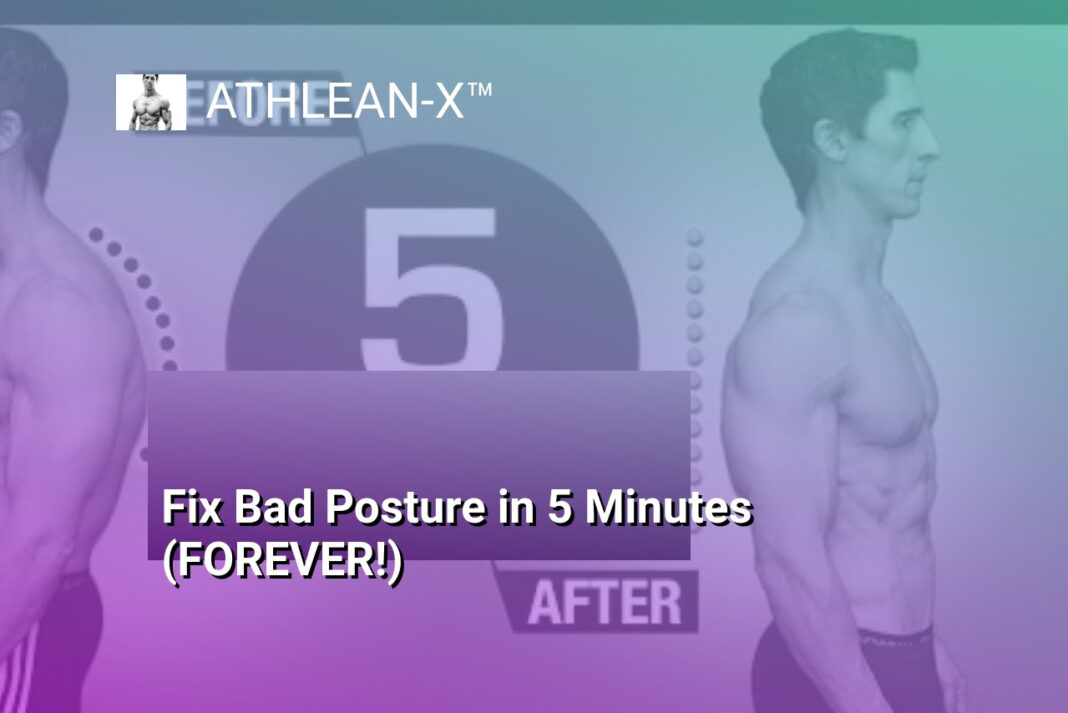The Bottom Line:
- The main theme of the text is to provide a quick and effective 5-minute routine to improve posture by targeting the thoracic area and glutes.
- The routine consists of 5 exercises, with 2 targeting the thoracic area, 2 targeting the glutes, and 1 combination exercise.
- The exercises are designed to be performed for 30 seconds each, with the option to repeat the second set of exercises for an additional 2.5 minutes.
- The exercises focus on improving thoracic extension, glute activation, and hip extension to address common posture issues.
- The author emphasizes the importance of consistency and making the routine manageable in order to create meaningful and lasting changes in posture.
Superman Exercise
The Superman Exercise
The first thoracic exercise in this routine is the Superman, which targets the upper back muscles that often contribute to poor posture. To perform this exercise, you’ll start by placing your fists on your sternum. Your goal is to spread your chest and dig your elbows into the floor, which will engage the muscles between your shoulder blades and allow you to lift your sternum up.
Think about the test you just did, where you lifted your hand as high as possible by lifting your sternum and tilting your body back. Perform this exercise as repetitions, doing as many high-quality reps as you can within the 30-second time frame. This exercise will help address the weakness in your upper back that can lead to poor posture.
The Glute March
The next exercise focuses on the glutes, specifically targeting your glute strength endurance. When it comes to posture issues, it’s not just about the overall strength of your glutes, but your ability to control and maintain that strength for an extended period.
The glute march is a great way to work on this. Start in a bridge position, creating a straight line from your thighs to your torso. Then, alternately lift your left and right feet about 5-6 inches off the ground, without allowing your pelvis to drop. The key is to perform quality repetitions for the 30-second duration, maintaining control and stability throughout the movement.
The Bridge and Reach Over
After completing the first two exercises, you’ll move on to the combo exercise, the Bridge and Reach Over. This exercise combines the thoracic rotation and extension with the glute activation that you’ve been working on.
Start in the bridge position again, but this time, reach your opposite arm across and back. This allows you to get that thoracic rotation and extension while also engaging the glutes to maintain the bridge position. Perform this exercise for 30 seconds, tying together the key elements you’ve been focusing on throughout the routine.
Remember, the key to creating meaningful change is consistency. This 5-minute routine is designed to be quick and effective, so you can easily incorporate it into your daily routine. By consistently performing these exercises, you’ll start to see improvements in your posture and glute activation over time.
Glute March
Glute March
The glute march is a fantastic exercise to target and strengthen the glutes, which are crucial for maintaining proper posture. This exercise focuses on improving your glute strength endurance, which is essential when it comes to addressing postural flaws.
To perform the glute march, start by getting into a bridge position, creating a straight line from your thighs to your torso. Keeping this position, begin alternating your foot lifts, raising each leg about 5-6 inches off the ground. The key is to avoid allowing any drop in your pelvis when you lift your leg. This ensures that you’re engaging your glutes to maintain the bridge position throughout the movement.
Perform the glute march for 30 seconds, focusing on quality repetitions. During this time, make sure you don’t let your pelvis sag or tilt to the side as you lift each leg. This controlled movement will help to activate and strengthen your glutes, giving you the endurance needed to maintain proper posture for extended periods.
Maintaining Proper Form
Proper form is crucial when performing the glute march. Remember to keep your body in a straight line, with your thighs and torso forming a straight plane. Engage your core muscles to stabilize your spine and prevent any sagging or arching in your lower back.
As you lift each leg, focus on driving through your heel and squeezing your glute muscle at the top of the movement. This will ensure that you’re targeting the right muscle groups and getting the most out of the exercise.
Incorporating the Glute March into Your Routine
The glute march is part of a larger 5-minute routine designed to improve posture and activate the glutes. By incorporating this exercise into your routine, along with the other targeted movements, you’ll be well on your way to better posture and a stronger, more stable core and lower body.
Remember, consistency is key when it comes to creating meaningful changes in your body. This 5-minute routine is designed to be quick and effective, making it easy to incorporate into your daily routine. Give it a try and see the benefits for yourself!
Bridge of Reach Over
Enhancing Thoracic Mobility and Glute Activation
The first thoracic exercise, the Superman, targets the upper back muscles that often contribute to poor posture. Lying on the floor, place your fists on the sternum and spread your chest, digging your elbows into the ground. This engages the muscles between the shoulder blades, allowing you to lift the sternum and tilt your upper back backward. Perform as many high-quality repetitions as possible within the 30-second time frame.
Strengthening Glute Endurance
The second exercise focuses on the glutes, specifically their endurance. In a bridge position, lift one foot about 5-6 inches off the ground, then alternate between the left and right legs without allowing the pelvis to drop. This challenges the glutes to maintain control and stability during the movement. Again, aim for quality repetitions over the 30-second duration.
Combining Thoracic and Glute Activation
The Bridge of Reach Over exercise combines the thoracic and glute components. Return to the bridge position, but this time, reach the opposite arm across and back, creating a thoracic rotation and extension while maintaining glute activation. This 30-second exercise ties together the previous exercises, addressing both the upper back and glute deficits simultaneously.
The second thoracic exercise utilizes a chair. Place your elbows on the chair and your hands on your upper back. Sink your chest towards the ground, focusing on leading with the chest and performing repetitions to target the thoracic region. This also provides a beneficial lat stretch, as the lats are internal rotators of the shoulder, contributing to poor posture.
The final glute exercise, the Wall DL, combines an RDL pattern with glute strengthening and thoracic extension reinforcement. Stand with your hands against a wall, drive one knee up, and hinge back, focusing on fully extending the hip to engage the glutes. Maintain contact with the wall to keep the thoracic extension.
This 5-minute routine, when performed consistently, can effectively improve posture and activate the glutes, addressing the common weaknesses that contribute to poor movement patterns.
Chest to Chair Exercise
Chest to Chair Exercise
The second thoracic exercise actually just requires a chair. You come down here on the floor and you take your elbows and you put them on top of the chair, and your hands are going to go on the top of your upper back. Now, at this point, your goal is to just sink yourself down, really trying to lead with your chest. In other words, try to touch your chest to the ground, obviously being limited by the fact that your elbows are preventing you from going too, too low.
This is great because it focuses in right on that area that we spoke about earlier. The key here is to perform these as repetitions as well by lifting up and then again resetting and dropping the chest down as best you can. The additional benefit that comes from this is that we’re getting a good lat stretch, and we know that the lats are also internal rotators of the shoulder contributing to more of that rounded, hunched posture, so we’re getting a double bang for our buck. Remember, perform high quality repetitions for 30 seconds and move on to the next glute exercise.
Wall Deadlift (Wall DL)
And that exercise is actually called a Wall DL, which is utilizing an RDL pattern, but it’s helping to strengthen those glutes once again and establish full hip extension while also reinforcing that thoracic extension that we’re looking for. So, you put your hands up against the wall like this and you drive your knee up into the wall as well. Now what we’re really focusing on is actually this down leg, because what I want to do at this point is kick my foot backwards to hinge but establish this flexed hip position and then drive off of that utilizing the glute to get through full hip extension. The only way I’m getting my knee back to the wall is to fully extend through the hip. And again, full hip extension is good glute activation and by doing that we’re fixing the pelvis from below and helping to reinforce that upper back.
And oh, by the way, the upper back is being reinforced in this position by keeping the hands in contact with the wall, which establishes the same dip that we had on that chair exercise to keep that extension that we’re looking for. The first time through you go 30 seconds on the right leg and the second time you perform this, you go 30 seconds on the left leg.
Bridge Reach Over
Now, with 30 seconds of each of those exercises performed, you’re now one minute into the routine. You repeat that combination one more time and you’re two minutes in total. Now, we’ve performed the 30 seconds, however, of that combination exercises. This is one of my all-time favorites is a Bridge of Reach Over. So now we’re going to go back to that bridge, but this time reach across and back with the opposite arm.
So, we’re getting that thoracic rotation and extension at the same time. We’re getting that lift in activation through the glutes so we can tie in both of these deficits and work on them all at one time and kind of bring it all together with just this final 30 seconds.
Wall Deadlift
Wall Deadlift
The wall deadlift is a variation of the traditional Romanian deadlift (RDL) that helps strengthen the glutes while also reinforcing thoracic extension. To perform this exercise, you’ll need to stand with your hands placed against a wall, with your feet positioned slightly behind your hips.
Begin by driving your knee up towards the wall, focusing on keeping the down leg straight and hinging at the hips to kick your foot back. As you hinge, concentrate on fully extending your hip to engage the glutes. The only way you’ll be able to bring your knee back to the wall is by fully extending through the hip, which helps to activate the glutes.
Maintaining contact between your hands and the wall also helps to reinforce the thoracic extension that we’re aiming for in this routine. This position mimics the same “dip” that you experienced in the previous chair exercise, ensuring that you maintain the desired upper back posture.
Perform this exercise for 30 seconds on the right leg, then switch and repeat for 30 seconds on the left leg. Remember to focus on quality of movement rather than the number of repetitions.
Reinforcing Thoracic Extension
The second thoracic exercise in this routine involves using a chair to target the upper back. Start by positioning your elbows on the seat of the chair, with your hands resting on the upper back. Your goal is to sink down, leading with your chest and trying to touch it to the ground, while being limited by the elbows.
This exercise not only focuses on the area of concern we discussed earlier, but it also provides a beneficial lat stretch. The lats are internal rotators of the shoulder, which can contribute to the rounded, hunched posture we’re trying to address.
Perform these repetitions for 30 seconds, focusing on quality of movement and proper form. Remember to reset and drop the chest down as best you can with each rep.
Combining Thoracic and Glute Activation
The final exercise in this routine is a combination of the thoracic and glute work we’ve been focusing on. It’s called the Bridge Reach Over, and it’s one of the coach’s all-time favorites.
Start in a bridge position, with a straight line from your thighs to your torso. This time, reach across your body with the opposite arm, getting that thoracic rotation and extension while also activating the glutes to maintain the bridge position.
This exercise allows you to tie together the deficits we’ve been addressing and work on them simultaneously, bringing everything together in a single 30-second period.
Remember, consistency is key when it comes to creating meaningful change. This routine is short and quick, but it’s designed to be highly effective. Stick with it, and you’ll start to see improvements in your posture and glute activation over time.





